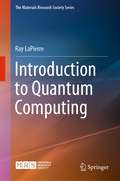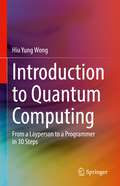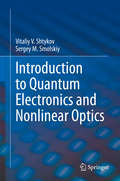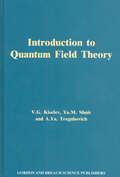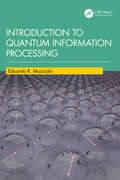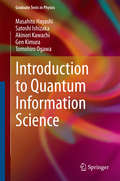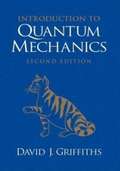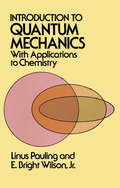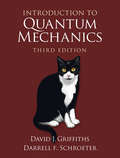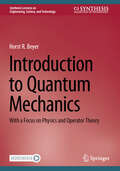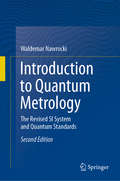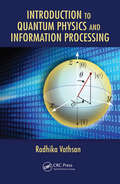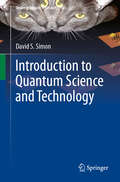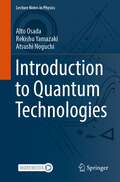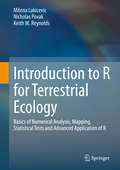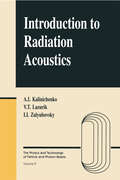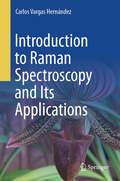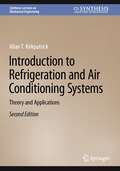- Table View
- List View
Introduction to Quantum Computing (The Materials Research Society Series)
by Ray LaPierreThis book provides a self-contained undergraduate course on quantum computing based on classroom-tested lecture notes. It reviews the fundamentals of quantum mechanics from the double-slit experiment to entanglement, before progressing to the basics of qubits, quantum gates, quantum circuits, quantum key distribution, and some of the famous quantum algorithms. As well as covering quantum gates in depth, it also describes promising platforms for their physical implementation, along with error correction, and topological quantum computing. With quantum computing expanding rapidly in the private sector, understanding quantum computing has never been so important for graduates entering the workplace or PhD programs. Assuming minimal background knowledge, this book is highly accessible, with rigorous step-by-step explanations of the principles behind quantum computation, further reading, and end-of-chapter exercises, ensuring that undergraduate students in physics and engineering emerge well prepared for the future.
Introduction to Quantum Computing: From a Layperson to a Programmer in 30 Steps
by Hiu Yung WongThis textbook introduces quantum computing to readers who do not have much background in linear algebra. The author targets undergraduate and master students, as well as non-CS and non-EE students who are willing to spend about 60 -90 hours seriously learning quantum computing. Readers will be able to write their program to simulate quantum computing algorithms and run on real quantum computers on IBM-Q. Moreover, unlike the books that only give superficial, “hand-waving” explanations, this book uses exact formalism so readers can continue to pursue more advanced topics based on what they learn from this book.Encourages students to embrace uncertainty over the daily classical experience, when encountering quantum phenomena;Uses narrative to start each section with analogies that help students to grasp the critical concept quickly;Uses numerical substitutions, accompanied by Python programming and IBM-Q quantum computer programming, as examples in teaching all critical concepts.
Introduction to Quantum Computing: From a Layperson to a Programmer in 30 Steps
by Hiu Yung WongThis textbook introduces quantum computing to readers who do not have much background in linear algebra based on the self-study experience of the author as an engineer. The author targets undergraduate and master students who are willing to spend about 60 -90 hours seriously learning quantum computing. This book is also suitable for self-study and teaching videos for each chapter and more than 200 exercises with answers are provided. Readers will be able to write their program to simulate quantum computing algorithms and run on real quantum computers on IBM-Q. Moreover, unlike books that only give superficial, “hand-waving” explanations, this book uses exact formalism so readers can continue to pursue more advanced topics based on what they learn from this book
Introduction to Quantum Control and Dynamics (Advances in Applied Mathematics)
by Domenico D’AlessandroThe introduction of control theory in quantum mechanics has created a rich, new interdisciplinary scientific field, which is producing novel insight into important theoretical questions at the heart of quantum physics. Exploring this emerging subject, Introduction to Quantum Control and Dynamics presents the mathematical concepts and fundamental physics behind the analysis and control of quantum dynamics, emphasizing the application of Lie algebra and Lie group theory. To advantage students, instructors and practitioners, and since the field is highly interdisciplinary, this book presents an introduction with all the basic notions in the same place. The field has seen a large development in parallel with the neighboring fields of quantum information, computation and communication. The author has maintained an introductory level to encourage course use. After introducing the basics of quantum mechanics, the book derives a class of models for quantum control systems from fundamental physics. It examines the controllability and observability of quantum systems and the related problem of quantum state determination and measurement. The author also uses Lie group decompositions as tools to analyze dynamics and to design control algorithms. In addition, he describes various other control methods and discusses topics in quantum information theory that include entanglement and entanglement dynamics. Changes to the New Edition: New Chapter 4: Uncontrollable Systems and Dynamical Decomposition New section on quantum control landscapes A brief discussion of the experiments that earned the 2012 Nobel Prize in Physics Corrections and revised concepts are made to improve accuracy Armed with the basics of quantum control and dynamics, readers will invariably use this interdisciplinary knowledge in their mathematics, physics and engineering work.
Introduction to Quantum Effects in Gravity
by V. Mukhanov S. WinitzkiThis is the first introductory textbook on quantum field theory in gravitational backgrounds intended for undergraduate and beginning graduate students in the fields of theoretical astrophysics, cosmology, particle physics, and string theory. The book covers the basic (but essential) material of quantization of fields in an expanding universe and quantum fluctuations in inflationary spacetime. It also contains a detailed explanation of the Casimir, Unruh, and Hawking effects, and introduces the method of effective action used for calculating the back-reaction of quantum systems on a classical external gravitational field. The broad scope of the material covered will provide the reader with a thorough perspective of the subject. Every major result is derived from first principles and thoroughly explained. The book is self-contained and assumes only a basic knowledge of general relativity. Exercises with detailed solutions are provided throughout the book.
Introduction to Quantum Electronics and Nonlinear Optics
by Sergey M. Smolskiy Vitaliy V. ShtykovThis textbook, based on the authors’ class-tested material, is accessible to students at the advanced undergraduate and graduate level in physics and engineering. While its primary function is didactic, this book’s comprehensive choice of topics and its clear and authoritative synthesis of ideas make it a useful reference for researchers, device engineers, and course instructors who wish to consolidate their knowledge of this field. The book takes the semi-classical approach where light is treated as a wave in accordance with the classical Maxwell equations, while matter is governed by quantum theory. It begins by introducing the postulates and mathematical framework of quantum theory, followed by the formalism of the density matrix which allows the transition from microscopic (quantum) quantities to macroscopic (classical) ones. Consequently, the equations describing the reaction of matter to the electromagnetic field in the form of polarization, magnetization, and current are derived. These equations (together with the Maxwell equations) form the complete system of equations sufficient to model a wide class of problems surrounding linear and nonlinear interactions of electromagnetic fields with matter. The nonlinear character of the governing equations determines parameters of the steady-state mode of the quantum generator and is also demonstrated in harmonic generation via propagation of laser radiation in various media. The touchstone description of magnetic phenomena will be of interest to scientists who deal with applications of magneto-resonance phenomena in biology and medicine. Other advanced topics covered include electric dipole transitions, magnetic dipole transitions, plasma transitions, and the devices that can be based on these and other electro-optical and nonlinear-optical systems. This textbook features numerous exercises, some of which are investigatory and some of which require computational solutions.
Introduction to Quantum Field Theory
by V.lG. Kiselev Ya.M. Shnir A.Ya. TregubovichThis text explains the features of quantum and statistical field systems that result from their field-theoretic nature and are common to different physical contexts. It supplies the practical tools for carrying out calculations and discusses the meaning of the results. The central concept is that of effective action (or free energy), and the main t
Introduction to Quantum Information Processing
by Eduardo R. MuccioloThis book introduces quantum computing and quantum communications at the undergraduate level for students in the physical sciences, engineering, and mathematics, assuming no prior knowledge of quantum mechanics. It is a self-contained guide assuming only that the reader is familiar with physics at the college level, calculus (up to and including ordinary differential equations), and some matrix algebra and complex numbers. The book brings the reader up to speed with fundamental concepts in quantum information processing and builds a working knowledge of basic quantum algorithms, quantum error correction, and quantum communication protocols. It covers various models of quantum computation and some of the most common physical realizations of qubits. There is a good number of practice problems and exercises that rely on computer programming with the Qiskit language. The book can be used to prepare students of physics, mathematics, electrical and computer engineering, computer science, optics and photonics, and mathematics for internships and research experiences in quantum information processing, both during and after their undergraduate studies. It also helps those who plan to apply to graduate school and do research in this area. Key Features: Self-contained coverage of quantum computing and quantum communications, from the motivations to the fundamentals and applications, including key concepts and contemporary topics. Contains practice problems and exercises, including some that require programming in Qiskit (the python-based, high-level language for programming quantum computers, adopted by nearly all quantum hardware providers and completely open source). Very light background knowledge assumed, making this book accessible to a variety of majors in the natural sciences, engineering, and mathematics.
Introduction to Quantum Information Science
by Masahito Hayashi Satoshi Ishizaka Akinori Kawachi Gen Kimura Tomohiro OgawaThis book presents the basics of quantum information, e. g. , foundation of quantum theory, quantum algorithms, quantum entanglement, quantum entropies, quantum coding, quantum error correction and quantum cryptography. The required knowledge is only elementary calculus and linear algebra. This way the book can be understood by undergraduate students. In order to study quantum information, one usually has to study the foundation of quantum theory. This book describes it from more an operational viewpoint which is suitable for quantum information while traditional textbooks of quantum theory lack this viewpoint. The current book bases on Shor's algorithm, Grover's algorithm, Deutsch-Jozsa's algorithm as basic algorithms. To treat several topics in quantum information, this book covers several kinds of information quantities in quantum systems including von Neumann entropy. The limits of several kinds of quantum information processing are given. As important quantum protocols, this book contains quantum teleportation, quantum dense coding, quantum data compression. In particular conversion theory of entanglement via local operation and classical communication are treated too. This theory provides the quantification of entanglement, which coincides with von Neumann entropy. The next part treats the quantum hypothesis testing. The decision problem of two candidates of the unknown state are given. The asymptotic performance of this problem is characterized by information quantities. Using this result, the optimal performance of classical information transmission via noisy quantum channel is derived. Quantum information transmission via noisy quantum channel by quantum error correction are discussed too. Based on this topic, the secure quantum communication is explained. In particular, the quantification of quantum security which has not been treated in existing book is explained. This book treats quantum cryptography from a more practical viewpoint.
Introduction to Quantum Mechanics
by David J. GriffithsFundamental principles are covered, quantum theory presented, and special techniques developed for attacking realistic problems. The book s two-part coverage organizes topics under basic theory, and assembles an arsenal of approximation schemes with illustrative applications. For physicists and engineers.
Introduction to Quantum Mechanics (Manchester Physics Series #40)
by A. C. PhillipsIntroduction to Quantum Mechanics is an introduction to the power and elegance of quantum mechanics. Assuming little in the way of prior knowledge, quantum concepts are carefully and precisely presented, and explored through numerous applications and problems. Some of the more challenging aspects that are essential for a modern appreciation of the subject have been included, but are introduced and developed in the simplest way possible. Undergraduates taking a first course on quantum mechanics will find this text an invaluable introduction to the field and help prepare them for more advanced courses. Introduction to Quantum Mechanics: * Starts from basics, reviewing relevant concepts of classical physics where needed. * Motivates by considering weird behaviour of quantum particles. * Presents mathematical arguments in their simplest form.
Introduction to Quantum Mechanics 1: Thermal Radiation and Experimental Facts of the Quantization of Matter
by Ibrahima SakhoThe conception of lasers and optoelectronic devices such as solar cells have been made possible, thanks to the modern day mastery of processes that harness the interaction of electromagnetic radiation with matter. This first volume is dedicated to thermal radiation and experimental facts that reveal the quantification of matter. The study of black body radiation allows the introduction of fundamental precepts such as Planck's law and the energy-related qualities that characterize radiation. The properties of light and wave–particle duality are also examined, based on the interpretation of light interferences, the photoelectric effect and the Compton effect. This book goes on to investigate the hydrogen atomic emission spectrum and how it dovetails into our understanding of quantum numbers to describe the energy, angular momentum, magnetic moment and spin of an electron. A look at the spectroscopic notation of the states explains the different wavelengths measured from the splitting of spectral lines. Finally, this first volume is completed by the study of de Broglie's wave theory and Heisenberg's uncertainty principle, which facilitated the advancement of quantum mechanics.
Introduction to Quantum Mechanics with Applications to Chemistry (Dover Books on Physics)
by Linus Pauling E. Bright Wilson Jr.When this classic text was first published in 1935, it fulfilled the goal of its authors "to produce a textbook of practical quantum mechanics for the chemist, the experimental physicist, and the beginning student of theoretical physics." Although many who are teachers today once worked with the book as students, the text is still as valuable for the same undergraduate audience.Two-time Nobel Prize winner Linus Pauling, Research Professor at the Linus Pauling Institute of Science and Medicine, Palo Alto, California, and E. Bright Wilson, Jr., Professor Emeritus of Chemistry at Harvard University, provide a readily understandable study of "wave mechanics," discussing the Schrodinger wave equation and the problems which can be solved with it. Extensive knowledge of mathematics is not required, although the student must have a grasp of elementary mathematics through the calculus. Pauling and Wilson begin with a survey of classical mechanics, including Newton's equations of motion in the Lagrangian form, and then move on to the "old" quantum theory, developed through the work of Planck, Einstein and Bohr. This analysis leads to the heart of the book ― an explanation of quantum mechanics which, as Schrodinger formulated it, "involves the renunciation of the hope of describing in exact detail the behavior of a system." Physics had created a new realm in which classical, Newtonian certainties were replaced by probabilities ― a change which Heisenberg's uncertainty principle (described in this book) subsequently reinforced.With clarity and precision, the authors guide the student from topic to topic, covering such subjects as the wave functions for the hydrogen atom, perturbation theory, the Pauli exclusion principle, the structure of simple and complex molecules, Van der Waals forces, and systems in thermodynamic equilibrium. To insure that the student can follow the mathematical derivations, Pauling and Wilson avoid the "temptation to condense the various discussions into shorter and perhaps more elegant forms" appropriate for a more advanced audience. Introduction to Quantum Mechanics is a perfect vehicle for demonstrating the practical application of quantum mechanics to a broad spectrum of chemical and physical problems.
Introduction to Quantum Mechanics: Pearson New International Edition
by David J. Griffiths Darrell F. SchroeterChanges and additions to the new edition of this classic textbook include a new chapter on symmetries, new problems and examples, improved explanations, more numerical problems to be worked on a computer, new applications to solid state physics, and consolidated treatment of time-dependent potentials.
Introduction to Quantum Mechanics: With a Focus on Physics and Operator Theory (Synthesis Lectures on Engineering, Science, and Technology)
by Horst R. BeyerThis book presents an introduction to quantum mechanics that consistently uses the methods of operator theory, allowing readers to develop a physical understanding of quantum mechanical systems. The methods of operator theory are discussed throughout the book and presented with a mathematically rigorous approach. The author describes in detail how to use the methods of operator theory for analyzing quantum mechanical systems, starting with the definition of the involved physical operators (observables) up to the calculation of their spectra, spectral measures, and functional calculus. In addition, the book includes the construction of exponential functions of the involved Hamilton operators that solve the problem of time evolution.
Introduction to Quantum Metrology
by Waldemar NawrockiThis book presents the theory of quantum effects used in metrology and results of the author's own research in the field of quantum electronics. The book provides also quantum measurement standards used in many branches of metrology for electrical quantities, mass, length, time and frequency. This book represents the first comprehensive survey of quantum metrology problems. As a scientific survey, it propagates a new approach to metrology with more emphasis on its connection with physics. This is of importance for the constantly developing technologies and nanotechnologies in particular. Providing a presentation of practical applications of the effects used in quantum metrology for the construction of quantum standards and sensitive electronic components, the book is useful for a wide audience of physicists and metrologists in the broad sense of both terms. In 2014 a new system of units, the so called Quantum SI, is introduced. This book helps to understand and approve the new system to both technology and academic community.
Introduction to Quantum Metrology: The Revised SI System and Quantum Standards
by Waldemar NawrockiThis book discusses the theory of quantum effects used in metrology, and presents the author’s research findings in the field of quantum electronics. It also describes the quantum measurement standards used in various branches of metrology, such as those relating to electrical quantities, mass, length, time and frequency.The first comprehensive survey of quantum metrology problems, it introduces a new approach to metrology, placing a greater emphasis on its connection with physics, which is of importance for developing new technologies, nanotechnology in particular. Presenting practical applications of the effects used in quantum metrology for the construction of quantum standards and sensitive electronic components, the book is useful for a broad range of physicists and metrologists. It also promotes a better understanding and approval of the new system in both industry and academia.This second edition includes two new chapters focusing on the revised SI system and satellite positioning systems. Practical realization (mise en pratique) the base units (metre, kilogram, second, ampere, kelvin, candela, and mole), new defined in the revised SI, is presented in details. Another new chapter describes satellite positioning systems and their possible applications. In satellite positioning systems, like GPS, GLONASS, BeiDou and Galileo, quantum devices – atomic clocks – serve wide population of users.
Introduction to Quantum Optics: From the Semi-classical Approach to Quantized Light
by Gilbert Grynberg Alain Aspect Claude Fabre Claude Cohen-TannoudjiCovering a number of important subjects in quantum optics, this textbook is an excellent introduction for advanced undergraduate and beginning graduate students, familiarizing readers with the basic concepts and formalism as well as the most recent advances. The first part of the textbook covers the semi-classical approach where matter is quantized, but light is not. It describes significant phenomena in quantum optics, including the principles of lasers. The second part is devoted to the full quantum description of light and its interaction with matter, covering topics such as spontaneous emission, and classical and non-classical states of light. An overview of photon entanglement and applications to quantum information is also given. In the third part, non-linear optics and laser cooling of atoms are presented, where using both approaches allows for a comprehensive description. Each chapter describes basic concepts in detail, and more specific concepts and phenomena are presented in 'complements'.
Introduction to Quantum Physics and Information Processing
by Radhika VathsanRequiring no background in quantum physics, this text guides beginners in understanding the current state of research in the novel, interdisciplinary area of quantum information. Suitable for undergraduate and beginning graduate students in physics, mathematics, or engineering, the book goes deep into issues of quantum theory without raising the technical level too much. It describes basic algorithms used in quantum computation and addresses key elements of quantum information. Examples, exercises, problems, and references encourage hands-on practice and further exploration.
Introduction to Quantum Science and Technology (Undergraduate Texts in Physics)
by David S. SimonThis textbook serves as a comprehensive introduction to quantum technology for advanced undergraduate and beginning graduate students in physics and engineering. It provides readers with an in-depth overview of the wide range of quantum technology applications, from more well-known areas of quantum computing and quantum cryptography to lesser-known applications such as quantum communication, quantum-assisted measurement and sensing, and quantum microscopy. This book only assumes that the reader has had the standard courses in quantum mechanics and electromagnetism that are normally taken by physics majors during their sophomore or junior years. The overall structure of this textbook is divided into four parts. Part I covers background material in elementary quantum mechanics, electromagnetism, optics, solid state physics, and other areas. Since the quantum states required for applications can exist in many types of physical systems, a broad background in many areas of physics is needed. This part of the book aims to ensure that all students have the necessary prerequisites, and to fill any gaps in their prior backgrounds. Part II covers additional topics in quantum mechanics beyond the basics. This includes topics such as interference of quantum states, unusual quantum effects that can be useful for applications, and the quantification of the amount of information carried by a quantum state. Part III is the heart of the book, discussing applications of the material from the previous chapters to real world problems such as high precision measurement, high resolution microscopy, quantum cryptography, and quantum information processing. Part IV covers more practical aspects, discussing detectors, light sources, atomic systems, and other topics that are essential for experimental implementation applications that were described from a more theoretical viewpoint in Part III. Each chapter also contains worked examples, additional problems, as well as supplementary "highlighted boxes" containing interesting applications, historical asides, advanced topics, or recent cutting-edge developments. This self-contained textbook provides a foundation for undergraduates that will prepare them to immediately enter quantum-based graduate research or to give them a head start when seeking employment in quantum-related industries.
Introduction to Quantum Technologies (Lecture Notes in Physics #1004)
by Alto Osada Rekishu Yamazaki Atsushi NoguchiThis book is a concise primer of quantum technology aiming at providing a comprehensive material of fundamentals to help beginners understand the common concepts and background theories to technologies for individual quantum systems. Further, it also describes how the concepts and theories are applied to technologies in various systems. This book consists of three parts. The first part looks back over basics of quantum mechanics necessary for the main content, including quantum state and operators, time evolution and perturbation theory. The second part explains in detail key components indispensable to follow quantum technologies: two-level systems, harmonic oscillator and cavity quantum electrodynamics and resonators. In the third part, the physical quantum systems are treated in a more abstract way by introducing quantum logic gates, quantum measurement and quantum error correction. Technical supplements are included in Appendices. The well-compiled topics and concise presentation feature the book as a supplemental primer in the courses of quantum technologies including quantum computing, quantum communication, quantum sensing and quantum simulation.
Introduction to R for Terrestrial Ecology: Basics of Numerical Analysis, Mapping, Statistical Tests and Advanced Application of R
by Keith M. Reynolds Milena Lakicevic Nicholas PovakThis textbook covers R data analysis related to environmental science, starting with basic examples and proceeding up to advanced applications of the R programming language. The main objective of the textbook is to serve as a guide for undergraduate students, who have no previous experience with R, but part of the textbook is dedicated to advanced R applications, and will also be useful for Masters and PhD students, and professionals. The textbook deals with solving specific programming tasks in R, and tasks are organized in terms of gradually increasing R proficiency, with examples getting more challenging as the chapters progress. The main competencies students will acquire from this textbook are: manipulating and processing data tablesperforming statistical testscreating maps in R This textbook will be useful in undergraduate and graduate courses in Advanced Landscape Ecology, Analysis of Ecological and Environmental Data, Ecological Modeling, Analytical Methods for Ecologists, Statistical Inference for Applied Research, Elements of Statistical Methods, Computational Ecology, Landscape Metrics and Spatial Statistics.
Introduction to Radiation Acoustics (The Physics and Technology of Particle and Photon Beams)
by Alexander Kalinichenko Valentine T. Lazurik Illya I. ZalyubovskyIn this volume, the author explains a generalized theory of radiation acoustic phenomena. This concise and comprehensive introduction to the field of radiation acoustics considers the nonlinear and non-thermal mechanisms of sound generation as well as the fundamental equations of radiation acoustics. The author also explores topics beyond theory and postulates some applications of radiation acoustic effects. Introduction to Radiation Acoustics is ideal for graduate students and specialists in the fields of accelerator techniques, acoustics, radiotherapeutics, and elementary particle physics.
Introduction to Raman Spectroscopy and Its Applications
by Carlos Vargas HernándezThe book explores theoretical foundations of Raman spectroscopy, looking into key concepts such as parameters, perturbation theories, normal vibration modes, and the application of group theory to specific structures. It also examines modifications of the Raman technique, particularly in the Surface Enhanced Raman Scattering (SERS) modality. Practical aspects of both Raman and SERS spectroscopy are covered in detail. Additionally, the book presents the characteristic Raman spectra of various materials measured by the author, along with a basic analysis of their molecular structures. This comprehensive approach ensures that readers gain a thorough understanding of both the theoretical and practical elements of Raman spectroscopy. Developed from the author's notes, research, and over a decade of teaching the Raman spectroscopy course, this book underscores the vital importance of spectroscopies in both academia and industry. These techniques are invaluable in the analytical field, offering powerful tools for the study and diagnosis of materials due to their capabilities for both quantitative and qualitative applications. Optical spectroscopies, inherently non-invasive, have gained popularity due to advancements in monochromatic sources and high-performance, high-resolution detectors, resulting in more versatile and portable instruments. Additionally, new methodologies for data acquisition and statistical analysis have been developed, reducing acquisition time and increasing the signal-to-noise ratio. Innovations in acquisition techniques, such as SERS, enable the acquisition of high-quality spectra from sample concentrations far below those required by conventional methods. The book offers a comprehensive introduction to one of the fastest-growing optical techniques, driven by advancements in optoelectronic and control devices. Aimed at final-year students in science and engineering, the text features clear mathematical explanations and explicit steps to help readers grasp the scope and applicability of the mathematical concepts involved. It serves as a foundational guide, equipping readers with the essential knowledge needed to tackle more complex models found in specialized literature.
Introduction to Refrigeration and Air Conditioning Systems: Theory and Applications (Synthesis Lectures on Mechanical Engineering)
by Allan T. KirkpatrickThis second edition builds on the foundation established by the previous first edition published in 2017. The first edition covered background information, description, and analysis of four major cooling system technologies - vapor compression cooling, evaporative cooling, absorption cooling, and gas cooling. The second edition has been expanded to include increased coverage of cooling system refrigerants, fluid mechanics, heat transfer, and building cooling loads. With increasing climate change due to the buildup of greenhouse gas emissions in the atmosphere, there has been a worldwide impetus to transition to cooling systems and refrigerants that have a low or even zero global warming potential. The text is written as a tutorial for engineering students and practicing engineers who want to become more familiar with the performance of refrigeration and air conditioning systems. The goals are to familiarize the reader with cooling technology nomenclature and provide insight into how refrigeration and air conditioning systems can be modeled and analyzed. Emphasis is placed on constructing idealized thermodynamic cycles to represent actual physical situations in cooling systems. The book contains numerous practical examples to show how one can calculate the performance of cooling system components. By becoming familiar with the analyses presented in the examples, one can gain a feel for representative values of the various thermal and mechanical parameters that characterize cooling systems.
